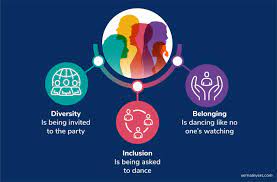In today’s diverse and dynamic world, fostering workplace diversity and inclusion is not just a moral imperative but also a strategic advantage. Organizations that embrace diversity and create inclusive environments are better positioned to attract top talent, drive innovation, and achieve sustainable growth. In this article, we explore key strategies for promoting workplace diversity and inclusion, from recruitment and culture to bias mitigation and accountability.
Introduction to Workplace Diversity and Inclusion
Workplace diversity refers to the presence of a variety of identities, backgrounds, and perspectives among employees, including but not limited to race, ethnicity, gender, age, sexual orientation, and disability. Inclusion, on the other hand, involves creating a culture where all individuals feel valued, respected, and empowered to contribute their unique talents and perspectives.
Understanding the Benefits of Diversity and Inclusion
Diverse and inclusive workplaces offer numerous benefits, both for employees and organizations. Research has shown that diverse teams are more innovative, creative, and effective at problem-solving, leading to better decision making and business outcomes. Moreover, fostering diversity and inclusion can enhance employee engagement, morale, and retention, driving organizational performance and competitive advantage.
Building a Diverse Workforce
To build a diverse workforce, organizations must actively recruit and attract talent from a wide range of backgrounds and demographics. This involves implementing strategies such as outreach programs, diversity-focused job postings, and partnerships with diverse organizations and educational institutions. Additionally, removing bias from the recruitment process, such as through blind resume reviews and structured interviews, is essential for promoting fairness and equity.
Fostering Inclusive Culture and Practices
Creating an inclusive culture requires more than just hiring diverse talent; it involves implementing policies, practices, and norms that promote fairness, respect, and belonging for all employees. This includes offering flexible work arrangements, providing diversity training and education, and establishing mentorship programs to support the growth and development of underrepresented groups. Promoting open communication, empathy, and respect among employees is also critical for fostering a culture of inclusion.
Empowering Diverse Voices and Perspectives
Inclusive organizations empower diverse employees to contribute their ideas, perspectives, and talents to decision-making processes. This involves providing opportunities for diverse voices to be heard and valued, as well as encouraging collaboration and teamwork across diverse teams. By leveraging the strengths of different backgrounds and experiences, organizations can drive innovation and creativity and achieve better business results.
Addressing Bias and Discrimination
Bias and discrimination can undermine efforts to promote diversity and inclusion in the workplace. Organizations must take proactive steps to address unconscious bias and discrimination through anti-bias training, awareness programs, and policies that promote fairness and equity. Establishing reporting mechanisms and channels for addressing instances of bias and discrimination promptly and effectively is also essential for creating a safe and inclusive work environment.
Celebrating Diversity and Promoting Equity
Recognizing and celebrating cultural diversity and heritage is an important aspect of fostering inclusion in the workplace. Organizations can organize events, initiatives, and employee resource groups to celebrate diversity and promote cross-cultural understanding and appreciation. Moreover, ensuring equitable access to opportunities, resources, and advancement for all employees, regardless of background or identity, is crucial for promoting fairness and equity.
Measuring Progress and Accountability
To drive meaningful change, organizations must establish diversity and inclusion metrics and goals to track progress and measure the impact of initiatives. This includes monitoring key indicators such as representation, retention, and employee satisfaction, as well as holding leaders and managers accountable for promoting diversity and inclusion and fostering inclusive behaviors and practices.
Engaging Stakeholders and Partnerships
Engaging with stakeholders, including employees, customers, and community organizations, is essential for informing diversity and inclusion strategies and initiatives. Organizations can form partnerships with external organizations and networks to advance diversity and inclusion goals, share best practices, and collaborate on diversity initiatives. By engaging stakeholders and building partnerships, organizations can leverage collective expertise and resources to drive meaningful change and create more inclusive workplaces.
Conclusion
In conclusion, promoting workplace diversity and inclusion is not just a moral imperative but also a strategic imperative for organizations seeking to thrive in today’s diverse and dynamic business environment. By implementing strategies to recruit and retain diverse talent, fostering an inclusive culture and practices, addressing bias and discrimination, and measuring progress and accountability, organizations can create workplaces where all individuals feel valued, respected, and empowered to succeed. Prioritizing diversity and inclusion is not only the right thing to do but also essential for driving innovation, growth, and sustainability in the long term.
